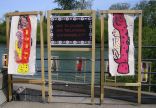Fierce Music:
Recognizing the Real Enemy
By Madronna Holden
This essay appeared in Parabola Magazine 27:4 (2003) and is copyright by Madronna Holden and Parabola.
Venerable shaman Grandmother Mingo risked her life to gain her own fierce music. She was from a village in Siberia, where the tradition of shamanism is perhaps the oldest on earth. Her spirits instructed her to come to the Northwest Coast for a visit, and to speak to us, her words had to be translated first from her native Nanai into Russian and then from Russian to English. But when Grandmother Mingo danced to bless us, no translation was necessary. The diminutive elder donned bells that appeared to weigh more than she did—and as she danced with them, her whole body became an instrument of the music she owned.
Her music needed to be fierce—or she would have died from the gift of her calling. As a child, she wandered the roads of the ancestors in her visions, meeting all that had assailed her people over the generations. When she lived through this, she gained music fierce enough to heal.
Like Grandmother Mingo, shamans are called to their profession on behalf of their people—and their strategies may be used to counter any assault on them. My grandfather’s grandmother, also a shaman, told this story about the strategy her village used on Napoleon’s army:
As Napoleon’s minions passed through Czech territory, villagers invited them to parties in their honor. While the young women sang and danced with the soldiers and plied them with alcohol until they fell sleep, village elders emptied the supplies and ammunition from the soldiers’ wagons and replaced them with straw. The next morning the soldiers left with smiles on their faces to continue their march to their fated engagement on the Russian front.
Traditional healers use their spirit songs in the same way these Czech peasants used their village music. Henry Cultee, elder of the Chehalis people of the Northwest Coast, told me that many ethnographers misperceived the “wars” his people spoke of, assuming they were like bloody European engagements. But in fact they were spiritual “fighting” of the kind illustrated in Chehalis tales, as when Ant and Bear sang against one another for the time of the world, or Rabbit saved himself from Cougar with his power song.
Elf uses such wily music to sing down a giant in a story from Picuris Pueblo whose theme bears striking similarities to the Czech incident. Here is an outline of that story, from the version given by Rosendo Vargas to John Harrington, in l918:
A giant who kidnapped and ate children found Elf and carried him off. Elf began to sing a lullaby: “A person who is very nice is packing me along”. As he sang, he jumped up and down to the rhythm of his song, making himself very heavy.
By the time he arrived home, the giant was so tired he went immediately to sleep. While he slept, Elf found the bones of the children the giant had devoured. He took medicine from his medicine bag and spit it on them, saying, “Little children, get up!” He sent two of the children to find pitch to cover him with for protection before he instructed all of them to take on the appearance of bones again. When the Giant woke up and put Elf into the cooking pot, Elf began to sing again, “A person who is very kind has put me in a warm place”.
The giant mumbled that Elf “was indeed a singer”, as he drifted off to sleep once more. Elf emerged from the pot, took the giant’s fire poker and killed him with it. He then roused the children. He told them to go home, where their poor parents were thinking about them, and he would go to his own home where his grandmother was thinking about him.
That is why there are no more giants. [i]
In this story fierce music creates both transformation and healing. Elf sings to the giant and the giant becomes a man soothed by a lullaby—after that “there are no more giants.” In like manner, the Czech villagers sing with Napoleon’s vast army, and it is transformed into ordinary young men dancing with young women. Importantly, as the giant and the soldiers “surrender” to the music, they enter into a personal relationship with the singers. The giant complements Elf on his music, remarking that Elf “is indeed a singer.” The soldiers dance and feast with the Czech villagers, leaving the village with smiles on their faces. If the latter are upset when they discover their ammunition missing—they will also understand the message this is in human terms.
These stories illustrate the tactic of personalizing a threat in order to disarm it—a tact taken by many traditional peoples. A Chehalis grandmother from the Pacific Northwest emphasized to me that she did not “scare her grandchildren” with stories of the Night People, spirits whose appearance accompanies death. The Night People “are just people like us”, she told her grandchildren. “They just feel things.” The Night People have a high pitched whistle for their own fierce music. After a pioneer killed a Chehalis man with a white flag of truce in his hand during the Indian Wars of l855-56,[ii] oral histories of both Chehalis and pioneer families recount the eerie whistles heard in the local forests. The pioneers thought these might be the signals of “enemy Indians”; the Chehalis took them for the whistles of the Night People. If the pioneers had had the Chehalis perspective, they might have understood how the spirits of this place resonated grief for the death of a man “just like us”.
In keeping with the strategy of personalizing an enemy, traditional warriors often earn their honor not in defeating or even attacking a foe, but in getting as close to it as possible. In counting coups there is more honor due a Sioux warrior for touching an enemy than for wounding him. And there is the least honor of all in killing him. The contrasting attempt to destroy an enemy may not only be futile, but unwise on psychological grounds. In The Sacred Hoop, informed by her Laguna Pueblo tradition, Paula Gunn Allen discusses how we need our enemies. We need our enemies to challenge us, to move us from our complacency, to make us as large in spirit as we might be, to fertilize our world—and to help us to understand that we do not control it.
The self-defeating results of actually obliterating an enemy are illustrated in an ancient story from India with much relevance today. In it, the god Agastya attacks certain irksome nature spirits. This he does by drinking up the habitat of these annoying creatures– his godlike power is that he can consume anything. Unfortunately, however, the creatures’ habitat is water: and Agastya must drink up all the water in the world in order to destroy them. His success in doing so initiates a drought that threatens all of life.
At the heart of this tale lies a profound truth: since everything in our world is related, wiping out an enemy only succeeds at the cost of wiping out a part of the self— and finally, at the cost of crippling life itself. This is the tragedy of any “final solution”, repeated today as nations amass weapons capable of destroying life on earth several times over in order to secure their capacity to obliterate their enemy.
In disarming any threat, however, it is rarely effective simply to throw more weapons into the fray. The cure for the crisis in the East Indian story is the fierce music to which Shiva dances. In response to the compassion of Prince Bagaritha, Shiva dances for his thirsty people, and as a result the healing waters of the Ganges River find safe passage from heaven to earth.
Lest we endanger the very life we mean to protect in our battles, we must name our enemy carefully— the apparent and the simplistic do not serve us in this. One of the shaman’s essential skills is the ability to locate the enemy of life and the thief of souls. To do this, shamans must traverse the realm of the invisible as well as the visible. And in their spiritual diagnosis, they ascertain not only who the enemy is, but who it is not. The enemy may not be the man who puts on the uniform of the opposing army, even if he fires a gun at us. As the Czech villagers understood, it was the soldiers’ ammunition—and their march in concert with empire— that was the enemy, and not the soldiers themselves. Myrlie Evers illustrates a parallel insight in her moving book, For Us, the Living, written in the wake of the murder of her husband, civil rights worker, Medgar Evers. With vision ample as any shaman’s, Evers tells us that her real enemy is not the man who killed her husband. In a larger sense, both her husband and her husband’s murderer were afflicted with the same disease of racism.
Native Spokane traditionalist Cliff Sijohn tells us more about discerning such enemies in the documentary, “Circle of Song”. In it, he takes two children to a mountaintop, where he tells them they will need vision large as the vista before them in order to walk their path in life. The music of their people will help them keep that course true: “What will take you across is song.” He also tells them how to recognize an enemy in life’s journey. Placing his hands over the children’s eyes, he says, “Your enemy is anyone who goes like this—anyone who stops you from seeing as far as you can.”
The racism Evers faced is such an enemy—as are all acts of prejudice, labeling, and objectification of other human beings. These diseases of the eye reverse the ancient process of healing. Instead of shrinking giants into “people like us”, they turn men and women into perceived monsters. And armies who implement such blindness are likely to become enemies of the security of their own people.
In 1982-3, I taught philosophy at BirZeit University. I lived in Ramallah, under military occupation. All military occupations inevitably objectify their subject populations in order to control them—and in this context, enforcing lines that divide people supercedes making opportunities for peace. Take this example: one day, Hebrew University students set out to have lunch at BirZeit University with their Palestinian counterparts. When the Territorial Administration got word of this, it took swift action to quell this peacemaking initiative. It directed its soldiers to intercept public buses en route to BirZeit and detain Israelis riding them to make sure they did not meet with any Palestinians.
Similar dynamics are likely to be found wherever subject populations are kept in their place by military force. In the early days of Washington Territory, pioneers were jailed for sharing a meal—ironically, thanksgiving dinner—with local Indians. Their real crime was the same as that of the Hebrew University students who came across the Green Line of Occupation. They crossed designated lines of division between people.
An African saying lends us additional perspective here: “Never give a sword to a man who can’t dance.” A man who can’t dance will suffer the limited vision caused by rigidity. He will not understand there is a time to yield as well as to hold the line, to connect as well as divide. And he will not understand those whom we perceive as our worst enemies may, under different conditions, be our greatest allies.
To meet our own battles well, we must know how to “dance”—to keep our strategies flexible. And we must open our eyes everywhere—including in the land of the dead. As the Picuris tale’s wisdom illustrates, we may well need a medicine to sing over the bones of the dead in order to restore the living. Indeed, when the memory of the dead is troubled, the psychic realms of the living and the dead become dangerously entangled. In Ramallah, in streets emptied by the Occupation, the haunting of the ghosts of the dead was palpable. Everyone I met, Palestinian or Israeli, had an intimate memory of the violent death of someone they knew. Palestinian mothers soberly state that they must bear an extra child, to make up for the one they believe will be killed under the Occupation.
It is in such an atmosphere that the suicide bombings are taking place. Shamanistic psychology gives us the words for the soul sickness these bombers both suffer and spread: their souls have surely been stolen by the ghosts of the grief, rancor and desperation that haunt this land. Tragically, those with such grave spiritual illness are not only ravaged by their disease— they take the lives of the innocent with them to the land of the dead.
What might we give the memory of the dead instead of the lives of the innocent? Acknowledgement is one essential thing. Mythologist Michael Meade says that the proper attitude after victory in war is mourning—mourning for lives taken by our own people as well as those taken by the enemy. Shared grief would not only be a palliative in the wounded Middle East. Such honest grieving would surely dampen the fervor of any country —including the United States— to start another war.
To treat the inevitable soul sickness caused by our intimacy with the ghosts of the dead killed by our hand or in our name, we must give these dead their due through our mourning for them. Then we must let them go to their peace—and our own. This is no small task. If it takes courage to walk into the land of the dead singing the fierce music of healing, it takes incomparable courage to do so when the body of a loved one lies on the ground before us. But there have been healers who can show us the way in this. Henry Cultee’s mother was one of these. A famous healer of the Lower Chehalis people, she possessed both Indian Shaker medicine and the older Indian Doctor power. If she faced a particularly difficult healing, she would sing her two medicines together: “My power help the shake.”
When this healer’s own father was murdered, a crowd of people gathered to pressure her to take revenge. She heard each of them out carefully. Then she drew a line on the earth in front of her and said, “The killing stops here”.
This was her medicine to sing over the body of her father.
We can emulate the heroic act of this spiritual leader in humbler ways in each of our lives. As the villagers’ response to Napoleon indicates, visionary activity can be found in acts like dancing with the soldiers who wear the uniform of the enemy. It can be found in the acts of the Hebrew University students who sought to increase their own vision and personalize those whom others called enemy. It can be found in the enduring hospitality of the Palestinians who urged me into their homes as a guest—whether or not they mistook me, in my Western clothes, for an Israeli.
It is contained in the everyday acts with which people anywhere seek to nurture a soulful home on their land—like those of the Palestinian elder, our neighbor in Ramallah, whose house was taken in the l967 War. Thus, by tradition, he lost his ability to have his own family. Still he is a peacemaker. He has a tongue-in-cheek cure for any who cover their own eyes—or those of their people— in order to “divide things”: “We should send them to the moon, so that they can look back on this earth and see that we all live on one world.” One day, I found him bent over an unlikely tree, amidst the rubble of bombed houses, carefully pulling thorn bushes away from its trunk. “It is a pear tree”, he told me, “It deserves to live.”
Acts such as these reflect the time-honored cure for those who languish in despair, apathy, or desperate grief—the cure of bringing the soul home. In accord with world-wide traditions, the healing conclusion of the Picuris tale comes when the children can go home again. A fully realized two-state agreement, in which both Palestinian and Israeli children can truly be at home on this land, concurs with ancient healing wisdom.
Bringing the soul home is visionary work that demands courage, compassion, creativity—and spiritual power that “goes on the side of life”[iii]. Such work needs doing in many places—including the contemporary United States. The first peoples of the Pacific Northwest saw psychic homelessness as a dangerous trait of our society from its inception. They called pioneers “drift people” for their inveterate restlessness, which by traditional standards, was a mark of soul loss.
The Chehalis grandmother I quoted above told me of her visit to a friend in a modern mental institution. She was horrified by the way the inmates “were paraded around like that—human beings!”
“In the old days”, she continued, she couldn’t remember that “there were many lost to us that way. But if there had been, we would have worked to bring them home again.”
Surely, we have many to bring home again today—many walls to take down between ourselves and others in a world that “divides things.” But the fierce music of generations of healers gives us a vision of the day when all peoples might sing to one another these words of a Hmong shaman’s song:
Come home to your house…
Come home to your family…
Come home
Come home
Come home. [iv]
Come home, such fierce music urges us. Come home to the fullness of life, in which the greatest battles we fight are for wholeness and healing.
—————————————-
[i] This story is included in Indian Tales from Picuris Pueblo, edited by Marta Weigle, Ancient City Press, Santa Fe, New Mexico: l989, pp. 37-39.
[ii] No Chehalis Indian ever attacked a pioneer during this “Indian War”. Nonetheless, pioneers were ordered by the Territorial authorities to gather into a local fort—an order which many declined to follow.
[iii] These are the moving words of a contemporary Muckleshoot elder, in facing the overwhelming struggle of her tribe to protect its sacred lands: “We can only go on the side of life.”
[iv] From Ann Fadiman, The Spirit Catches You and You Fall Down; The Noonday Press, New York: l997, pp. 287-288.






































Leave a comment